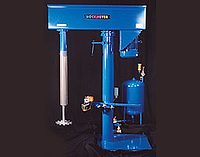High Speed Inner Space Cleaning Increases Productivity
You may remember having seen children playing with toy air guns that fire foam rubber Nerf balls. This concept is the same -- if you replace the toy air gun with a heavy-duty portable industrial version. Next, trade the Nerf balls for open cell controlled density urethane foam pellets that displace, wipe and squeegee the product or material from the internal surfaces of piping, tubing, and hose networks.
The portable cleaning system is inexpensive as a capital cost and operational expense. However, the maintenance department will try to borrow the launching gun and pellets from the manufacturing group.
Many older process lines were placed into service prior to the advent of process pigging. These networks are made up of screwed piping, elbows, unions, and partial throat plug valves rather than full bore ball valves, semi-restrictive quick coupling devices, "T," "Y," and "U" configurations and a host of other partial restrictions. The pellets can successfully negotiate these kinds of networks, but don't expect to shoot pellets through most metering devices, filters or gate type valves.
Some of the more obvious production applications are these older piping configurations, production spray booths where squeezing out the different coating products from the booth's manifold tubing saves product, limits turnaround time, and reduces the usage of cleaning solvents. Another production application is the purging of colored resins from feed lines to production molding machines. Finally, there is the plant that would like to do pigging, but would prefer not to invest a significant amount of money until they can actually see a pilot operation.
Launching systems are available to suit different size application and can be used with an array of connecting mechanisms. Generally speaking, the launcher's size and corresponding connecting mechanism are determined by the inside diameter or diameters of the networks to be purged and the condition and type of inlet. Systems are typically available for applications ranging in size from 1/8-3 inches internal diameter. Cam-Lock adaptors are commonly used to connect the portable launching gun to the network inlet ranging 1-3 inches. However, the adapters can be used on smaller size tubing applications using a fabricated decreaser. Smaller diameters ranging from 1/4-2 inch networks use a set of pipe, hose, or tube adaptor nozzles to allow the launching gun to interface with these networks.
The pellet-launching guns are fitted with a pressure gage, pressure relief valve and an airflow control trigger. As an accessory, a network pressure-testing attachment is available for attachment to the launching gun.
The pellets themselves are constructed of open cell virgin or reconstituted polyurethane foam and are available in various densities. They have a cylindrical shape with a length approximately 1.6 times the diameter, and range in diameter from 4 to 100mm. The rule of thumb is to select a pellet that is 120% of the process line network's maximum inside diameter. Once the pellet is compressed through the launcher gun nozzle, the projectile encompasses the full 360¿ internal surface and forces out the product as well as squeezing the piping walls. Pellet velocity is controlled at a suitable recovery rate of 3-10 feet per second controlled by the launching gun's pneumatic flow control trigger. The pellets are sturdy enough to purge and clean networks of the varying inside diameters. The pellets are available in standard type (5 lb. per cubic foot) or coupling type (3.5 lb. per cubic foot) densities. The pellets are manufactured with an abrasive head or grinding circumference for occasional removal of hardened product build-up often found in the process pipeline network. The only requirement for this cleaning and purging process is to have an entrance and an exit and a clean compressed air or nitrogen source of approximately 85-100 psi. The entrance is the Cam-Lock or nozzle connection. The exit can be anything from a bag filter frame or bucket to catch the pellet while at the same time diverting the product to tankage through a "tee" mounted ball valve.
So why would the maintenance department keep taking the manufacturing group's equipment? Because it is portable, and very useful in a number of areas in HVAC maintenance situations -- the plant's air-conditioning system itself, boiler tubes, shell and tube heat exchangers, steam generation equipment and steam line decalcification. Other areas where maintenance will apply the system include forklift truck hydraulic systems and other pneumatic and hydraulic systems.
A number of manufacturers have recognized the advantages of using gas propelled foam pellets over the traditional drain and flush method. The cost of loss of salable product, the cost of downtime, the cost of disposal of solvents and cleaning fluids in general is always rising. All these savings add up to having this type of technology pass any cost/benefit test one might apply.
Portable pellet launching systems can often solve many of the problem areas typically encountered in manufacturing and maintenance without the costs of having a mechanical contractor install dedicated launchers and receivers in each individual process line. In other words, a single air tool and a series of adapters to address all the applications. Just load and shoot!
For more information, contact John Nehrbass, P.E., Fluid Recovery Systems Inc., 442 Monterey Road, Palatine, IL 60074; e-mail pfrs@earthlink.net; phone 847/359.7552; or Circle Number 149.
Looking for a reprint of this article?
From high-res PDFs to custom plaques, order your copy today!





